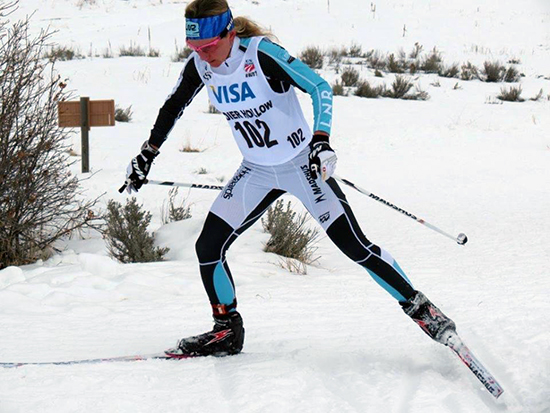
On Tuesday, February 24, Caitlin (Compton) Gregg did something no U.S. woman had done before her – she skied swiftly enough to win a medal at the cross-country skiing world championships. As the eventual bronze medalist in the 10-kilometer freestyle race, she would soon be joined by fellow American Jessie Diggins, who was even speedier than Gregg, finishing in the silver-medal position.
Gregg, now living in Minnesota, grew up skiing in the Mad River Valley and shortly after her medal-winning performance she was quick to credit those in The Valley who helped her in her formative years. "Ole's was a huge part of my success," she said. "Without that support, I don't think I could have done this."
To say that having two Americans on the podium was an upset would be a sizeable understatement; to have predicted that Gregg would be one of those medalists would have been hubris in extremis. Although she had won four U.S. national titles, Gregg hadn't cracked the top 30 in her previous 15 World Cup races before her bronze-medal run at the championships in Falun, Sweden.
In her previous World Cup 10k free race, on December 12 in Davos, Switzerland, she had finished 54th, or next to last, more than four minutes behind winner Marit Bjoergen of Norway. In Falun, she finished more than a minute and a half ahead of Bjoergen, who, shockingly, ended up in 31st place.
The questions in the immediate aftermath of the race basically boiled down to the same thing: How could something like this happen? Cross-country ski racing is a complicated business and a single reason can't explain the unexpected 10k results. A conspiracy of factors was no doubt in play and here's an amateur post-race analysis from a continent away from the event.
As any cross-country ski racer knows, the arcane business of matching ski wax (and other elements of ski preparation) to the prevailing snow conditions is a crucial factor to skiing fast. And, as any wax technician knows, it can be a nightmare preparing skis when conditions are changeable. Sometimes, a wax tech will take several pairs of skis to the start, selecting the best skis only after an up-to-the-minute analysis of the weather and the snow.
Gregg started with at least two things in her favor. As a lower-seeded racer, she started early in the order – third – with skiers going off at 30-second intervals. It was a day in which warm, sticky snow would fall more heavily as the race progressed and Gregg would complete her race before the new snow had amounted to much of anything. That made the choice of skis for her technicians relatively straightforward. And she was fresh; she hadn't competed in a major event in more than a month. The 10k would be the only event she would enter in Falun, enabling her to concentrate all of her effort on a single race.
On the other hand, the heavily favored Norwegian women started late in the order. Bjoergen started 65th, Therese Johaug, 63rd, and Heidi Weng, 61st, at a time in the proceedings when the snow was really coming down. That was clearly bad luck, given the weather, but just as clearly the Norwegian wax techs miscalculated in their choice of ski preparation. Weng, in 22nd, was the top Norwegian, a result as shocking as Gregg's bronze medal.
In addition, the Norwegians were anything but fresh. Bjoergen, for example, was in the midst of a grueling race campaign, dominating the World Cup and overwhelming the field in the multi-day Tour de Ski in early January. Just a few days before the 10k race, she had won the world-championship sprint race, but on Saturday, three days before the 10k, she looked exhausted, finishing sixth in the two-event skiathlon.
At the beginning of any season, competitors chart their race schedules in such a way as to have their fitness and mental focus at their peak for the events that count the most. Bjoergen and her fellow Norwegians might have missed the wax, as they say, but they also missed out on peaking for the 10k race. Poorly prepared skis can't explain entirely the almost six-minute swing in the time differential between Bjoergen's and Gregg's races in Davos and Falun.
So rock on, Caitlin, and wear that medal proudly. Everyone from your home turf – at Ole's, at Blueberry Lake and at Harwood, where you first started racing – is mighty proud of what you have done.





